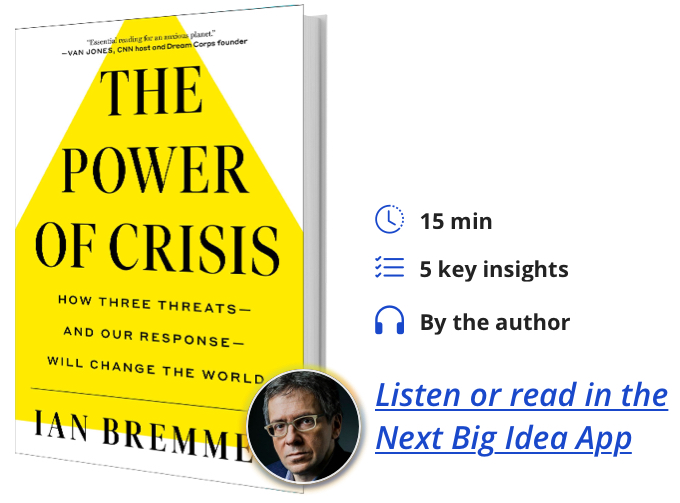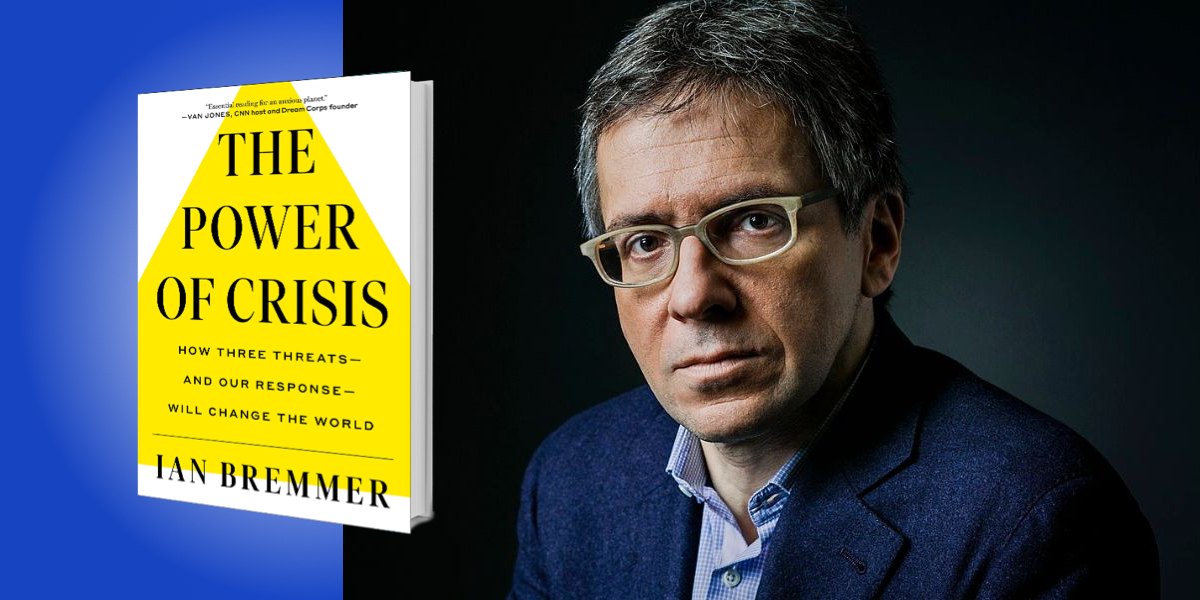Ian Bremmer is president and founder of Eurasia Group, the world’s leading global research and consulting firm, and GZERO Media, a company dedicated to providing intelligent and engaging coverage of international affairs. Ian is also a frequent guest on CNN, Fox News, MSNBC, the BBC, Bloomberg, and many other television stations around the world.
Below, Ian shares 5 key insights from his new book, The Power of Crisis: How Three Threats—and Our Response—Will Change the World. Listen to the audio version—read by Ian himself—in the Next Big Idea App.

1. We are increasingly a planet of anxious people, facing all sorts of crises that we don’t know how to respond to.
The reason that we are in this crisis is not because our leaders are bad. It’s because geopolitics, just like economics, go through cycles. You know about economic recessions, boom and bust cycles—in the United States, we’ve had one every seven years, on average, since World War II. Geopolitics have cycles too, and right now, we are in a geopolitical recession, a time when our institutions are no longer aligned with the balance of power in the world.
They were when we created them, but then the world changed, and our institutions stayed sticky. That happens. You buy a car, you drive it for a while, you get it tuned up, but eventually, you need a new car. You don’t say, “Oh my God, the car is no good. I’m going to walk everywhere from now on.” You get a new car—but you have to get from here to that new car. Well, we have to get from here to these new institutions. In our current crises are the seeds of a new, better, more fit global order.
You’d think that all crises are problematic, but actually the crisis we need—one that has the power to make a difference—is a “Goldilocks crisis.” It isn’t so small that we ignore it and don’t use it to change our institutions going forward. But you don’t want it to be too big so that you feel like there’s nothing you can do. You don’t want it to be World War I, and everything comes crashing down. No, the crisis we need, the crisis that has power, is a crisis that is not too big and not too small. And thankfully, that’s exactly the size of many of the crises that we’re facing today.
2. The pandemic is not a Goldilocks crisis.
We’ve just been through two years of global pandemic, and there were indications in the first few months that indeed it was a Goldilocks crisis. We all idolized Dr. Fauci. We couldn’t wait to see what he was going to tell us to do, and we needed information. The United States and much of the world came together to throw enormous amounts of economic support at its populations. Not just elites, not just businesses, but also regular working men and women, to ensure that we got through the pandemic. And that led to a V-shaped recovery, much better than people expected.
But we were so fast in developing vaccines and therapeutics that the United States and Europe started paying much less attention to the pandemic too early. As a consequence, the pandemic became politicized, especially in the U.S. In the middle of an electoral cycle, it became more about blue states versus red states, blaming politicians from the other side, and politicizing even the science and the CDC than it was about using the pandemic to increase our resilience.
“The United States and Europe started paying much less attention to the pandemic too early.”
Meanwhile in China, watching millions die in the United States and Europe, they felt confident when their economy was open again. They were complacent, and they didn’t change their zero COVID response while the pandemic changed around the world and we got new variants. And today, they have a zero COVID response that is inadequate to Omicron, with its great infectiousness leading to rolling lockdowns in China and much more substantial challenges in economic growth. So no, the pandemic was not a Goldilocks crisis.
3. The Russian invasion of Ukraine is a Goldilocks crisis.
On February 24th, two days before I had to put the manuscript for The Power of Crisis to bed, the Russians invaded Ukraine. Thirty years of a peace dividend gone overnight, shattered when the Russians showed that the European continent was at war once again. This is a Goldilocks crisis.
I see it this way for a couple of reasons. First, it’s an invasion of Ukraine, but it’s not World War III. It is something that Americans and Europeans are capable of responding to, but it requires sacrifice. Second, the United States, its core allies, and the advanced industrial nations, are on one side of it. You have to look really, really hard to find anyone who thinks that Putin’s position in invading Ukraine is justified. A little bit of Tucker Carlson, a little bit of Noam Chomsky—but beyond that, really nobody. Furthermore, as the crisis continued, all of your prior beliefs were being confirmed. You believed even more in the rightness and courageousness of the Ukrainian cause. You believed more that the Russians had to be stopped, as you saw the evidence of thousands of war crimes against Ukrainian civilians. Hundreds of thousands of Ukrainians were forcibly moved to filtration camps in Russia. And millions of Ukrainian refugees—mostly women, children, and the elderly—moved across Europe and were taken into others’ homes.
As that happened, the willingness of Americans and Europeans to respond—by strengthening and expanding NATO, by spending on their collective defense, by providing enormous amounts of support to the Ukrainians, and by putting unprecedented levels of sanctions against Russia—that was proven. So NATO, considered brain-dead by French President Macron and obsolete by former U.S. President Trump, was suddenly becoming stronger. The E.U. is becoming stronger because of the Russian invasion of Ukraine, not in spite of it.
“The E.U. is becoming stronger because of the Russian invasion of Ukraine, not in spite of it.”
4. Climate change is a Goldilocks crisis.
The climate wasn’t always a Goldilocks crisis. It wasn’t the world coming together decades ago the way NATO came together after Russia invaded Ukraine. Thirty years ago, it was mostly activists who focused on hugging trees and saving whales—it wasn’t getting global attention the way it certainly deserved. But over time, it became abundantly clear to people around the world—to young people, NGOs, governors, mayors, bankers, corporate executives—that this was becoming a bigger problem. So much so that today, everyone agrees on the basic science.
Every year, 195 countries get together, and they talk about the fact that we now have 1.2 degrees Centigrade of climate change. It’s not being caused by a cycle in nature—it’s caused by human beings emitting carbon and methane into the atmosphere. In a world of polarization and fake news, the fact that there is no more fake news on climate is an extraordinary positive.
Everyone is now on one basic side of the issue, even if they differ dramatically on how much they’re willing to prioritize or spend toward it. And every day this goes on, people’s prior beliefs are, yet again, being confirmed. They see more and more that it’s affecting them, and their family, and their neighborhood. Whether you’re in Florida, California, Australia, Italy, or India, around the world, billions of people are collectively being impacted by climate change—and it is growing in importance over time.
And what that has meant is that countries and corporations around the world, even if they don’t trust each other, are spending more and more on new technologies developed at scale—so much so that now, solar power is cheaper than coal. So much so that within one generation, a majority of the world’s energy will no longer come from fossil fuels, but rather from nuclear and renewable sources.
Now, there is an enormous difference between 1.5 degrees Centigrade and 2.5 degrees Centigrade. It’s hundreds of millions of lives, and trillions and trillions of dollars. That’s why we need to continue to focus on this as a meaningful crisis that requires an urgent response. But this crisis itself is what is causing a new global order on energy, new institutions with multiple stakeholders that aren’t just governments, but rather are public and private sector, are national-level, state-level, and local-level, and involve individuals as well. That is an extraordinary turn of our global order that we have a major crisis to thank.
“Now, solar power is cheaper than coal.”
5. Disruptive technology is (hopefully) a Goldilocks crisis.
To be fair, I’m not sure if it is. Unlike the pandemic, unlike the Russian invasion of Ukraine, unlike climate change, it is not immediately in front of us yet—but it’s coming fast. When I was younger, the biggest concern I had in disruptive technology was nuclear weapons and their proliferation. Even though the Americans and the Soviets were trying to defeat each other, we knew that we couldn’t afford direct confrontation and war, because that would mean blowing up each other and indeed the whole planet. As a consequence, there was a lot of effort between the Americans and the Soviets to ensure that we had arms control—and also to limit the proliferation of nuclear weapons beyond the existing small nuclear club. Over 80 years of history of nuclear weapons, we weren’t completely successful. But on balance, we did a pretty good job—and hey, we’re all still here.
So far, we’ve had a Goldilocks crisis with nuclear proliferation, but we have new, 21st-century disruptive technologies like lethal autonomous weapons, offensive cyber capabilities, bioweapons, quantum computing and algorithms, and artificial intelligence that allows for deep fakes—you can’t even tell who’s a person and who isn’t. So far, there has been literally no international effort to try to reduce the proliferation of these technologies that will, in short order, make humanity vulnerable.
The first part of the solution is to identify the problem; if you all agree on what the problem is, it’s a lot easier to start fixing it. What we need to do is create an intergovernmental panel of coders, technologists, public policy types, activists, and leaders and ask them, “What is the nature of the challenge of disruptive technologies? Which are particularly dangerous? Who are the actors that possess them, or might? Which are the technologies that you can potentially defend against? Which can you really not?”
Then you can create the individual groups that will work to try to limit the impact of that expansion. Not everyone works together on all of climate change. You have different groups working on biodiversity, deforestation, methane, carbon, investment in new technologies, etc. The same thing would be true with disruptive technologies; different groups would focus on weapons and space, on bioweapons, on offensive cyber capabilities. Some would focus mostly on governments, some would have certain private sector actors. Nonetheless, that would be the process that would eventually get us to the point where you would have a set of global leaders that could have the same conversation about 21st-century technologies that could destroy us as Ronald Reagan and Gorbachev did some decades ago about nuclear proliferation and arms control.
To listen to the audio version read by author Ian Bremmer, download the Next Big Idea App today:






























